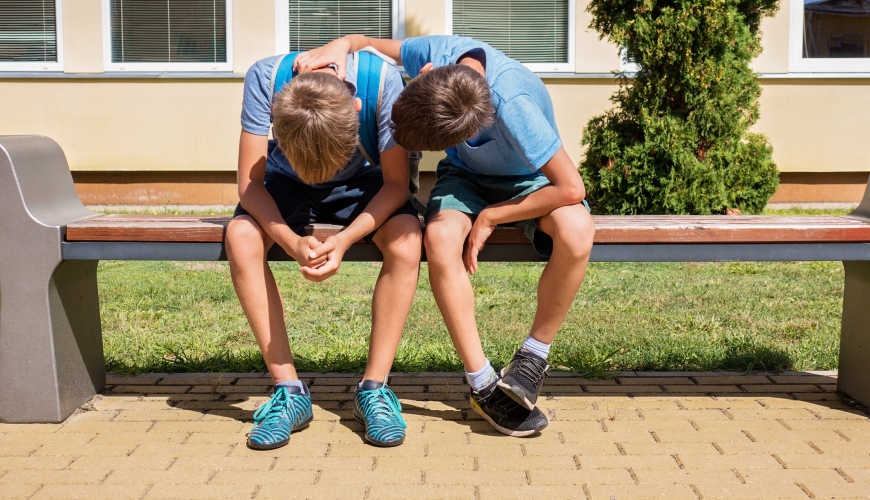What is bullying?
If you are being bullied and need support, it is important that you read this factsheet and go to the Get Help section. If you know or see someone being bullied go to the Supportive Bystander Fact Sheet to find out how to help them.
What is bullying?
Bullying is when people repeatedly and intentionally use words or actions against someone or a group of people to cause distress and risk to their wellbeing. These actions are usually done by people who have more influence or power over someone else, or who want to make someone else feel less powerful or helpless.
Bullying is not the same as conflict between people (like having a fight) or disliking someone, even though people might bully each other because of conflict or dislike.
The sort of repeated behaviour that can be considered bullying includes:
- Keeping someone out of a group (online or offline)
- Acting in an unpleasant way near or towards someone
- Giving nasty looks, making rude gestures, calling names, being rude and impolite, and constantly negative teasing.
- Spreading rumours or lies, or misrepresenting someone (i.e. using their Facebook account to post messages as if it were them)
- Mucking about that goes too far
- Harassing someone based on their race, sex, religion, gender or a disability
- Intentionally and repeatedly hurting someone physically
- Intentionally stalking someone
- Taking advantage of any power over someone else like a Prefect or a Student Representative.
Bullying can happen anywhere. It can be in schools, at home, at work, in online social spaces, via text messaging or via email. It can be physical, verbal, emotional, and it also includes messages, public statements and behaviour online intended to cause distress or harm (also known as cyberbullying). But no matter what form bullying takes, the results can be the same: severe distress and pain for the person being bullied.
Types of bullying
Face-to-face bullying (sometimes referred to as direct bullying) involves physical actions such as punching or kicking or direct verbal actions such as name-calling and insulting.
Covert bullying (sometimes referred to as indirect bullying) is less direct, but just as painful. It means bullying which isn’t easily seen by others and is conducted out of sight, such as excluding people from groups or spreading lies or rumours. Because it is less obvious, it is often unacknowledged by adults.
Cyberbullying occurs through the use of information or communication technologies such Instant Messaging or chat, text messages, email and social networking sites or forums. It has many similarities with offline bullying, but it can also be anonymous, it can reach a wide audience, and sent or uploaded material can be difficult to remove. Most people who cyberbully also bully off-line.
How can bullying affect you?
Bullying affects everyone in different ways. But there are common feelings that come up when you are being bullied.
How bullying can affect individuals:
- Feeling guilty like it is your fault
- Feeling hopeless and stuck like you can’t get out of the situation
- Feeling alone, like there is no one to help you
- Feeling like you don’t fit in with the cool group
- Feeling depressed and rejected by your friends and other groups of people
- Feeling unsafe and afraid
- Feeling confused and stressed out wondering what to do and why this is happening to you
- Feeling ashamed that this is happening to you
How bullying can affect other people:
Bullying can have a negative impact on everyone – it is not just a problem for victims and bullies. If you see or know of others been bullied you may feel angry, fearful, guilty, and sad.
You may feel as bad as those who are being bullied.
You may also feel worried that the bullying could happen to you.
When bullying isn’t stopped or challenged by anyone it can create an environment where bullying is accepted and where everyone feels powerless to stop it.
Know your rights
You have a right to feel safe and to be treated fairly and respectfully. Bullying is a serious problem with serious mental and physical impacts. Bullying can violate many of your human rights including:
- your right to be free from mental, emotional and physical violence
- your right to education
- your right to a safe work environment
For more information about your rights go to the Know Your Rights Fact Sheet.
Why do people bully others?
People bully for different reasons. Those who bully persistently are likely to do so in order to dominate others and improve their social status. They may have high self esteem, show little regret for their bullying behaviour and not see bullying as morally wrong.
Other people may bully out of anger or frustration, they may struggle socially and coul d have also been victims of bullying.
What can you do to stop bullies?
- If you know or see someone who is being bullied, access our Supportive Bystander Fact Sheet.
- If you are being bullied, you should talk to someone you know well and trust; they will give you much needed support and will often have suggestions you hadn't considered for helping with the situation.
- You might feel more comfortable taking a friend with you to talk to the bully or when seeking help. If you feel you might get too nervous to speak, write down what you'd like to say on paper or in an email.
- If you feel safe and confident, you should approach the person who is bullying you and tell them that their behaviour is unwanted and not acceptable.
- If you are being bullied while at school, it is a good idea to seek help from a friend, or to talk to a teacher or counsellor to see if they can help.
- If you are being bullied at work, check out our Workplace Bullying Fact Sheet.
Getting help
If you have been bullied or witnessed others been bullied:
- Review this list of helpful websites and referral services
- Kids Help Line (1800 55 1800) is a free and confidential, telephone counselling service for 5 to 25 year olds in Australia.
- Lifeline (13 11 14) is a free and confidential service staffed by trained telephone counsellors.
- The Australian Human Rights Commission (1300 656 419) has a complaint handling service that may investigate complaints of discrimination, harassment and bullying.
Further reading
- Understand what Cyberbullying looks like, what to do and how to get help
- Explore advice and resources on being a Supportive Bystander
- Recognise Workplace Bullying, its impact and what you can do
- Be informed about Human Rights, their origins and the international human rights system
This Violence, Harassment and Bullying fact sheet was developed in partnership with the ReachOut.com, 2011


